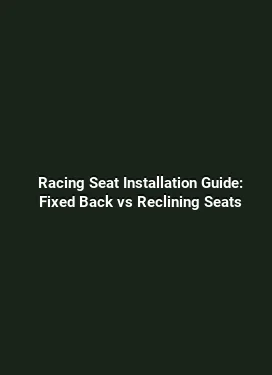Racing Pedal Box Installation for Better Heel-Toe Downshifting
In high-performance driving, precise throttle modulation and seamless downshifts are essential. A racing pedal box offers a refined interface that optimizes pedal travel, response, and ergonomics to support an accurate heel-toe technique. This guide provides a comprehensive, practical approach to selecting, fitting, calibrating, and maintaining a pedal box while emphasizing interior and safety considerations. By understanding the interaction between pedal geometry, brake and throttle inputs, and driver posture, enthusiasts can achieve a more consistent and confident downshift, whether on a track day or spirited street sessions.
Understanding the Racing Pedal Box and Its Benefits

A racing pedal box is an add-on assembly that replaces or augments the stock pedal arrangement. It typically includes adjustable throttle, brake, and sometimes clutch inputs, a modular mounting platform, and a dedicated linkage or electronic signal path to the vehicle’s engine or transmission control unit. The primary advantages are improved pedal feel, reduced pedal travel, and a more linear throttle response. For heel-toe practice, the layout is designed to accommodate tight heel-and-toe actions without requiring excessive foot movement, enabling faster rev-matches and smoother downshifts during corner entries.
For racers and enthusiasts, the benefits extend beyond raw performance. A well-configured pedal box can reduce driver fatigue by providing a natural pedal stance and a predictable response curve. It also allows customization of pedal effort and position to fit different shoe types, foot sizes, and driving styles. When installed with attention to ergonomic alignment, pedal travel, and brake bias, a pedal box contributes to safer, more confident control in dynamic driving scenarios.
Pedal Geometry, Ergonomics, and Signal Integrity

The geometry of the pedal box determines how the toe and heel interact with the pedals. A well-designed system minimizes lateral foot movement and promotes a stable heel rest while enabling quick throttle blips. Signal integrity is critical when the box interfaces with the vehicle’s control systems. High-quality sensors or opto-mechanical linkages ensure consistent input signals, reducing the risk of drift or lag during aggressive downshifts. Consider the mounting surface, pedal pad material, and anti-slip coatings to preserve control under wet or oily conditions.
Material and Build Quality
Racing pedal boxes are commonly crafted from lightweight alloys or reinforced composites to withstand repeated pedal strokes and vibration. Aluminum is valued for its strength-to-weight ratio and thermal stability, while reinforced polymers can offer vibration damping. For interior safety, inspect bolts, collars, and mounting brackets for fatigue resistance and secure fasteners with lock-washers or thread-locking compounds as appropriate. A robust pedal box also minimizes movement under braking forces, maintaining alignment between the brake master cylinder input and throttle linkage.
Step-by-Step Installation and Setup
Preparation begins with a clear workspace, a vehicle that is safely parked and secured, and a set of precise tools. Before removing any original pedals, study the vehicle’s service manual to understand mounting points, wire routing, and potential interference with the steering column, airbags, or brake lines. A systematic approach reduces the risk of misalignment and electrical cross-talk during the upgrade.
Plan and Measure: Layout and Clearance
Begin by removing accessories that could obstruct the installation, such as floor mats or trim pieces near the pedal area. Use a measuring tape and a straight edge to establish reference lines for the pedal box position. Assess clearance between the new pedal box and the existing brake master cylinder, accelerator cable, and firewall. The optimal stance places the heel comfortably on the fixed rest while allowing a full range of motion for the toes to reach the throttle, even during aggressive braking events.
Mounting and Alignment
Secure the pedal box to a reinforced mounting surface or the car’s chassis where approved by the manufacturer. Tighten bolts in a cross pattern to prevent distortion. Recheck the pedal spacing with the driver seated in a typical posture: knee angle should be approximately 110 to 120 degrees, and the seat should allow a slight bend in the ankle at rest. Align the pedals with a consistent vertical plane so the toe can rotate smoothly between the brake and throttle without scraping or binding. A dry-fit test with the engine off helps verify clearance and reach before final fasteners are torqued to specification.
Linkage, Sensors, and Electrical Integration
Whether the pedal box uses mechanical linkage or electronic sensors, ensure the input path is free of binding and that travel is linear across the entire range. Route cables away from heat sources, moving parts, and moisture-prone areas. If wiring is involved, secure harnesses with clamps or zip ties, protect exposed sections with loom, and maintain strain relief to prevent intermittent signals. Perform an initial bench test to confirm that the box registers throttle and brake inputs accurately via the vehicle’s control interface, following the manufacturer’s calibration procedure step by step.
Calibration for Ideal Heel-Toe Response
Calibration focuses on producing a predictable throttle response during engine braking. Start with a moderate brake pressure and a high enough rev-matching target for the engine. Adjust the throttle curve to yield a smooth upshift or downshift without abrupt surges. Fine-tune the pedal box’s dead zones, response time, and any programmable rev-match thresholds. Document each setting during a test run, then refine based on feel and consistency across multiple gears and speeds. A well-calibrated system should deliver rev-matched downshifts that feel natural and repeatable rather than abrupt or delayed.
Safety Considerations and Ergonomic Enhancements
Interior safety is paramount when introducing any modification to the pedal area. The installation should not compromise airbag deployment zones, knee bolsters, or steering wheel clearance. In performance contexts, pedal box deployment must be resistant to heat, dust, and minor impacts while preserving driveability in normal conditions. Ergonomics play a critical role in reducing fatigue, enabling drivers to maintain precise control across long sessions and varied track layouts.
Impact on Safety Systems and Vehicle Dynamics
Evaluate how the pedal box interacts with safety systems, including ABS and traction control. In some configurations, electrical interfaces may require clamping or reprogramming to preserve correct signaling. If in doubt, consult a qualified technician to verify compatibility and to prevent unintended disengagement of safety features. Ensure the installation does not obstruct pedal travel in the event of a sudden steering input or side impact, and verify that all cabling remains secure under aggressive driving dynamics.
Ergonomics: Driver Posture and Reach
A comfortable driving position helps maintain precision during heel-toe downshifts. Adjust seat height, tilt, and lumbar support to align the hips with the pedals’ pin, enabling a stable heel rest. Consider pedal rake and mounting height to reduce toe cramping and improve return motion. Footwear matters as well; select shoes with a flat sole and a reasonably stiff midsole to maximize pedal feel without excessive bending of the ankle.
Maintenance and Longevity
Regular inspections are essential to detect wear or loosening of brackets and pins. Periodically verify that fasteners remain tight, especially after track events or aggressive driving. Clean pedal pads and linkage surfaces to prevent debris from altering pedal travel. If the pedal box features removable pads, inspect their mounting hardware and replace worn components to maintain grip and feel. A preventive maintenance routine extends the life of the system and preserves consistent performance across sessions.
Practical Scenarios: From Street to Track
On a tight corner exit, a well-tuned pedal box helps a driver maintain engine braking without overcommitting to the brake pedal. The heel can anchor on the floor while the toe works the throttle, allowing rapid rev-matching as the chassis settles. In a high-speed sweep, precise throttle modulation helps maintain line and momentum, reducing the need for abrupt gear shifts. For rally or endurance driving, consistent pedal feedback reduces cognitive load, enabling the driver to focus on line, posture, and feedback from the tires.
When approaching downshifts in a corner, the pedal box’s calibrated response should allow a quick snap of throttle without requiring large foot repositioning. Practitioners often record their shifts during a few laps, then adjust the curve to eliminate drag on the throttle or unexpected lag. By iterating the calibration and validating with data or a seat-time log, drivers build muscle memory for consistent heel-toe technique across gear ratios and engine speeds.
Common Challenges and Troubleshooting
Issues may include misalignment, binding, or inconsistent sensor readings. If the accelerator input seems delayed, inspect the linkage for kinks or friction points and confirm that the sensor is calibrated to the correct range. Brake input drift can occur if routing introduces electrical interference or if the master cylinder movement is affected by the new geometry. Revisit alignment and re-torque critical fasteners after a few sessions. For shoes with aggressive soles, add a non-slip pad to ensure stable heel contact without altering pedal travel.
In challenging setups, consider professional installation or a factory-approved kit that provides optimized geometry and factory-backed support. A properly chosen kit often includes detailed mounting templates, pre-wired harnesses, and an explicit calibration workflow designed to minimize guesswork and ensure repeatable results across different cars and environments.
Maintenance, Upgrades, and Longevity
Maintenance is a blend of inspection, cleaning, and timely upgrades as technology evolves. Track-oriented enthusiasts may opt for a pedal box with modular sensor options that allow updating the throttle curve or brake input profile without replacing the entire system. Regularly inspect the pedal pads for wear, confirm that protective coatings remain intact, and verify that all adjustment mechanisms operate smoothly. When upgrading, verify compatibility with the vehicle’s electronics, including any dash readouts or data logging systems you rely on for performance analysis.
In addition to mechanical upkeep, consider incorporating data-aware techniques. Recording pedal travel, brake pressure, and engine speed during practice sessions yields actionable insights into how heel-toe execution can be refined. Analyzing these metrics over multiple sessions helps identify subtle improvements in response times and consistency, informing future adjustment choices and driver training goals.
Final Checks Before a Session
Before entering a session, double-check the mounting hardware, ensure there are no loose cables or heat sources near the wiring, and verify that the pedals return to neutral with a clear, repeatable stopping point. Confirm optical or electronic feedback on the dash corresponds to pedal inputs, and perform a brief test at reduced engine speed to confirm normal operation. A thorough pre-session checklist reduces the likelihood of mid-session interruptions and ensures the pedal box remains a reliable part of the cockpit environment.
Conclusion: Integrating Performance with Safety
Installing a racing pedal box provides tangible improvements in heel-toe downshifting and overall pedal precision when approached with careful planning, precise execution, and ongoing attention to ergonomic and safety considerations. The outcome is a cockpit that combines responsive control with enhanced driver confidence, enabling more consistent downshifts, improved engine braking, and a more enjoyable driving experience on both public roads and track environments.






